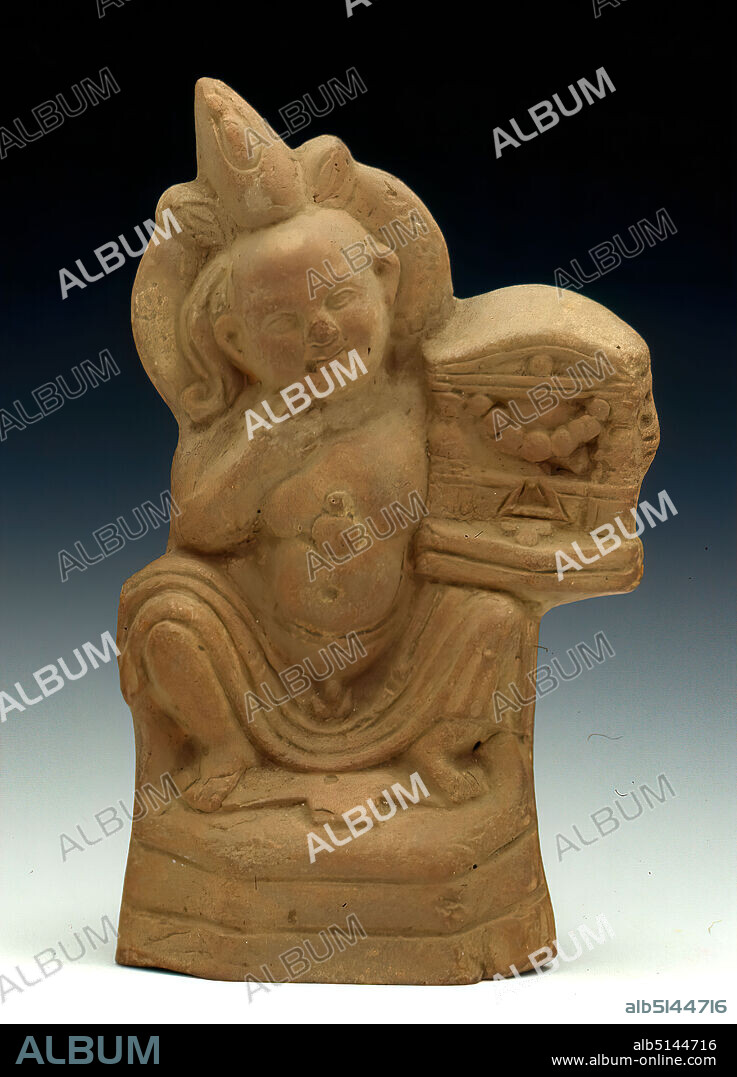alb5144716
Harpocrates with temple shrine, clay, pressed into the form, hand-modeled, fired (ceramic), clay, Total: Height: 14.4 cm; Width: 9.4 cm; Depth: 5 cm, Pottery, Egyptian gods, demigods, heroes, Harpocrates, seated figure, Early Imperial period, Middle Imperial period, Late Imperial period, The childlike, corpulent harpocrates with youth curl is enthroned on a profiled hexagonal base with a blanket With his left hand he holds a small temple shrine placed on his knee. He has led his right index finger to his mouth in a gesture typical of the god. He is naked except for a cloth laid over his thighs, which leaves his thick belly and penis free. On his chest lies a so-called heart amulet. The skull is decorated with a wreath and the double crown flanked by two buds. Harpocrates, Horus as a child, is the most favored figure among the Greco-Roman terracottas besides the goddess Isis. The depictions have undergone a thorough Hellenization, whereby native Egyptian features are always connected with Greek ones. The shaven head with horus curl is Egyptian. The temple shrine is - as the comparisons show - quite rare. The figure belongs to the group of the so-called Fayum terracottas. In Alexandria, the international, Greek-influenced center of Egypt, lived a multicultural society of Egyptians, Orientals, Greeks, Romans, Jews and others, whose different religious ideas gradually merged. Insights into this world of faith are provided by the so-called Fayum terracottas. They are part of the religious household, children's toys, knick-knacks, but also cult symbols, grave goods, pilgrimage images, votive offerings and magical objects for banishing evil forces. They can be found in houses, graves and sanctuaries.

|
Ajouter à une autre Lightbox |
|
Ajouter à une autre Lightbox |



Avez-vous déjà un compte? S'identifier
Vous n'avez pas de compte ? S'inscrire
Acheter cette image

Légende:
Voir la traduction automatique
Harpocrates with temple shrine, clay, pressed into the form, hand-modeled, fired (ceramic), clay, Total: Height: 14.4 cm; Width: 9.4 cm; Depth: 5 cm, Pottery, Egyptian gods, demigods, heroes, Harpocrates, seated figure, Early Imperial period, Middle Imperial period, Late Imperial period, The childlike, corpulent harpocrates with youth curl is enthroned on a profiled hexagonal base with a blanket With his left hand he holds a small temple shrine placed on his knee. He has led his right index finger to his mouth in a gesture typical of the god. He is naked except for a cloth laid over his thighs, which leaves his thick belly and penis free. On his chest lies a so-called heart amulet. The skull is decorated with a wreath and the double crown flanked by two buds. Harpocrates, Horus as a child, is the most favored figure among the Greco-Roman terracottas besides the goddess Isis. The depictions have undergone a thorough Hellenization, whereby native Egyptian features are always connected with Greek ones. The shaven head with horus curl is Egyptian. The temple shrine is - as the comparisons show - quite rare. The figure belongs to the group of the so-called Fayum terracottas. In Alexandria, the international, Greek-influenced center of Egypt, lived a multicultural society of Egyptians, Orientals, Greeks, Romans, Jews and others, whose different religious ideas gradually merged. Insights into this world of faith are provided by the so-called Fayum terracottas. They are part of the religious household, children's toys, knick-knacks, but also cult symbols, grave goods, pilgrimage images, votive offerings and magical objects for banishing evil forces. They can be found in houses, graves and sanctuaries.
Personnalités:
Crédit:
Album / quintlox
Autorisations:
Modèle: Non - Propriété: Non
Questions sur les droits?
Questions sur les droits?
Taille de l'image:
3110 x 4320 px | 38.4 MB
Taille d'impression:
26.3 x 36.6 cm | 10.4 x 14.4 in (300 dpi)
Mots clés:
ALEXANDRIE • ANATOMIE: CRANE • ANATOMIE: CRANES • ARGILE • BIBELOT • BIBELOTS • BOUCHE • CERAMIQUE • CONFIANCE • CORPS CRANE • COUETTE • CRANE • CRÂNES • DECORATION • DECORATIONS • DIEU • DIEUX • DIEUX: EGYPTIENS • EGYPTE • ÉGYPTIEN • ÉGYPTIENNE • FEUILLAGE • FOI • FORMULAIRE • GRAOUPE • GROUPE • INTERNATIONAL • JUIF (ADJECTIF) • JUIF • JUIFS (NOM) • JUIFS • JUIVE • MAISON • MAISONS • MATERIAU CERAMIQUE • MATERIAU TERRE CUITE • MONDE • MORT CRANE • ORNEMENT • ORNEMENTS • PARURE • POTERIE • RELIGIOSITE • TERRE CUITE, VAISSELLE • TETE DE MORT • TUMBAS • VAISSELLE EN TERRE CUITE
 Pinterest
Pinterest Twitter
Twitter Facebook
Facebook Copier le lien
Copier le lien Email
Email
